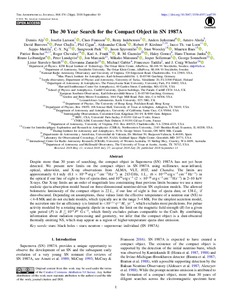The 30 Year Search for the Compact Object in SN 1987A
Alp D; Larsson J; Fransson C; Indebetouw R; Jerkstrand A; Ahola A; Burrows D; Challis P; Cigan P; Cikota A; Kirshner RP; van Loon JT; Mattila S; Ng CY; Park S; Spyromilio J; Woosley S; Baes M; Bouchet P; Chevalier R; Frank KA; Gaensler BM; Gomez H; Janka HT; Leibundgut B; Lundqvist P; Marcaide J; Matsuura M; Sollerman J; Sonneborn G; Staveley-Smith L; Zanardo G; Gabler M; Taddia F; Wheeler JC; Taddia F; Wheeler JC
The 30 Year Search for the Compact Object in SN 1987A
Alp D
Larsson J
Fransson C
Indebetouw R
Jerkstrand A
Ahola A
Burrows D
Challis P
Cigan P
Cikota A
Kirshner RP
van Loon JT
Mattila S
Ng CY
Park S
Spyromilio J
Woosley S
Baes M
Bouchet P
Chevalier R
Frank KA
Gaensler BM
Gomez H
Janka HT
Leibundgut B
Lundqvist P
Marcaide J
Matsuura M
Sollerman J
Sonneborn G
Staveley-Smith L
Zanardo G
Gabler M
Taddia F
Wheeler JC
Taddia F
Wheeler JC
IOP PUBLISHING LTD
Julkaisun pysyvä osoite on:
https://urn.fi/URN:NBN:fi-fe2021042719878
https://urn.fi/URN:NBN:fi-fe2021042719878
Tiivistelmä
Despite more than 30 years of searching, the compact object in Supernova (SN) 1987A has not yet been detected. We present new limits on the compact object in SN 1987A using millimeter, near-infrared, optical, ultraviolet, and X-ray observations from ALMA, VLT, HST, and Chandra. The limits are approximately 0.1 mJy (0.1 x 10(-26) erg s(-1) cm(-2) Hz(-1)) at 213 GHz, 1 L-circle dot (6 x 10(-29) erg s(-1) cm(-2) Hz(-1)) in the optical if our line of sight is free of ejecta dust, and 10(36) erg s(-1) (2 x 10(-30) erg s(-1) cm(-2) Hz(-1) ) in 2-10 keV X-rays. Our X-ray limits are an order of magnitude less constraining than previous limits because we use a more realistic ejecta absorption model based on three-dimensional neutrino-driven SN explosion models. The allowed bolometric luminosity of the compact object is 22 L-circle dot if our line of sight is free of ejecta dust, or 138L(circle dot) if dust-obscured. Depending on assumptions, these values limit the effective temperature of a neutron star (NS) to <4-8 MK and do not exclude models, which typically are in the range 3-4 MK. For the simplest accretion model, the accretion rate for an efficiency 77 is limited to <10(-11) eta(-1) M-circle dot yr(-1), which excludes most predictions. For pulsar activity modeled by a rotating magnetic dipole in vacuum, the limit on the magnetic field strength (B) for a given spin period (P) is B less than or similar to 10(14) P-2 G s(-2), which firmly excludes pulsars comparable to the Crab. By combining information about radiation reprocessing and geometry, we infer that the compact object is a dust-obscured thermally emitting NS, which may appear as a region of higher-temperature ejecta dust emission.
Kokoelmat
- Rinnakkaistallenteet [27094]
